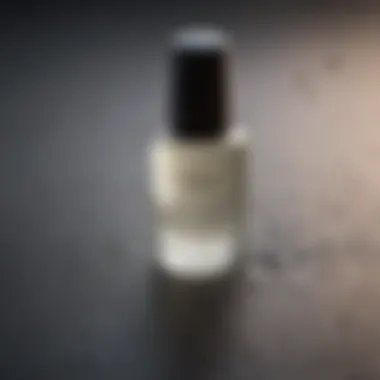Top Drugstore Shampoos That Effectively Fight Dandruff


Intro
Dandruff has become a common concern for many, making the search for effective treatments essential. Drugstore shampoos represent a practical option for addressing this issue without exhaustive spending. This guide reviews various effective drugstore shampoos specifically formulated for dandruff, evaluating key ingredients and offering judicious insights into how to select and apply these products. We aim to empower you with knowledge, allowing you to make informed decisions for effective dandruff management.
Trend Report
In the world of hair care, products designed for dandruff treatment have seen significant advancements over the years. Here are the recent trends shaping the landscape of dandruff solutions:
Latest Formulation Trends
Modern formulations often incorporate a blend of traditional active ingredients and cutting-edge technologies. Utilization of natural ingredients, such as tea tree oil, aloe vera, and salicylic acid, are frequent in many popular shampoos today. These formulations not only target flakes but also promote overall scalp health.
Challenges of Budget-friendly Care
Staying budget-friendly is an ongoing challenge for consumers with high-quality expectations. Drugstore shampoos provide a range of affordable options without sacrificing efficacy. This trend indicates a shift as consumers continue seeking products that give the same results as salon brands.
The quest for effective and budget-friendly solutions shows the market is responding positively to consumer demand.
Inclusion of Dermatologically Approved Options
Many drugstore brands are now producing shampoos clinically tested and approved by dermatologists. This trend highlights an increase in consumer awareness in distinguishing suitable products, ensuring efficacy and minimizing potential irritation.Several products boast gentle exfoliation and soothing properties aimed at irritated scalps, indicating a thoughtful approach in formulation.
These trends show a forward-looking change in how consumers are turning to therapies that don't just treat symptoms but also promote long-term scalp well-being.
By recognizing these trends, individuals with dandruff can make educated choices in their product selection, leading to effective treatment and healthier hair overall.
Understanding Dandruff
Gaining insight into the characteristics and nature of dandruff is crucial for managing this common scalp condition effectively. By comprehending its underlying causes, typical symptoms, and various types, individuals can make informed decisions about interventions. This section aims to outline the fundamental elements of dandruff, enhancing readers’ awareness so they can identify proper treatment options and remedies.
What Causes Dandruff?
Dandruff is often linked to multiple factors. The most frequent cause is a reaction to a yeast-like fungus known as Malassezia. This organism thrives on the scalp, breaking down oils which might result in irritation. When the scalp reacts to the buildup of this fungus, it hastens the lifecycle of skin cells, leading to flaking and shedding.
In addition, factors such as dry skin, hormonal changes, and allergic reactions to hair products play an important role. Those with oily scalp conditions may also find greater prevalence of dandruff. Understanding the primary contributors to dandruff is essential for tailoring an effective treatment plan.
Common Symptoms of Dandruff
Recognizing the symptoms associated with dandruff is vital, especially when evaluating the condition. Those experiencing dandruff often notice:
- Flaking Skin: This may fall onto clothing or appear on the scalp when brushed.
- Itching: The scalp usually feels scratchy, inviting irritation.
- Redness: Severe cases can result in inflammation or soreness alongside flakes.
While these symptoms may be evident, their severity can vary significantly among individuals. Addressing them promptly aids in managing discomfort and maintaining scalp health.
Types of Dandruff
There are essentially two mainstream types of dandruff: dry and oily. Each type reflects different scalp conditions and has its unique characteristics.
- Dry Dandruff: This is typically associated with a dry, moist environment. The flakes oftentimes appear small and white, easily shedding onto shoulders.
- Oily Dandruff: It is observed on individuals with oilier scalps, which results in larger, yellowish flakes clinging to the scalp.
Recognizing the type of dandruff present can better influence the choice of shampoo and overall treatment protocol. It essentially helps target management strategies to combat flakes efficiently.
An informed understanding of dandruff reinforces the opportunity for better scalp care and treatment effectiveness.
Thus, this knowledge supports the broader conversation about allocating attention to effective drugstore shampoo selection and application.
Choosing the Right Drugstore Shampoo
Selecting a suitable drugstore shampoo is crucial for effectively managing dandruff. Many of the options available on the market vary widely in ingredients and effectiveness. An informed choice can ensure that you counteract the cause of dandruff rather than merely masking its symptoms.
Considerations such as hair type, scalp condition, and key ingredients play significant roles in this process. Awareness of active ingredients and their benefits can help consumers find a product that meets their specific needs.
Furthermore, making an educated choice can potentially save time and money, reducing trial-and-error with various products.
Key Ingredients to Look For
When searching for an effective anti-dandruff shampoo, understanding the key ingredients is essential. Foundation of success lies in knowing how each component functions in addressing dandruff.


Zinc Pyrithione
Zinc pyrithione is well regarded for its dual action in addressing dandruff. It helps in fighting the malassezia fungus often linked to dandruff. Moreover, it has antibacterial properties. These features make it a reliable option.
The unique quality of zinc pyrithione is its ability to provide long-lasting effects. Regular use can lead to noticeable improvements in scalp health. However, some users may experience sensitivity which should be monitored.
Ketoconazole
Ketoconazole is another potent ingredient offered in many anti-dandruff shampoos. This antifungal treatment is effective against various scalp conditions, including dandruff and seborrheic dermatitis.
The key characteristic of ketoconazole is its ability to combat yeast accumulation on the scalp. This special action helps keep dandruff at bay. Its application may sometimes cause dryness for some, necessitating a quality conditioner alongside its use.
Selenium Sulfide
Selenium sulfide is effective due to its action on scalp conditions and contributes to reducing flakes and itchiness. It has been commonly used in medicated shampoos specifically for dandruff treatment. Its strong antifungal property is beneficial, providing a tangible reduction in dandruff symptoms.
The distinctiveness of selenium sulfide is in its capacity to slow the rate of skin cell turnover on the scalp. While it is effective, its use may cause discoloration of hair in some individuals. Also, it may leave an oily residue, prompting a follow-up wash with regular shampoo.
Salicylic Acid
Salicylic acid works by promoting cell turnover and eliminating dead skin which can often lead to dandruff. In addition, it can help attune the scalp, offering a fresh surface for hair growth. This acid serves as an exfoliant, allowing better penetration of subsequent treatments.
What sets salicylic acid apart is its role in preventing crust formation on the scalp. While generally safe, excessive use may lead to scalp dryness and irritation. Therefore, moderation is key when incorporating this ingredient.
Avoiding Harmful Additives
Just as vital as understanding effective ingredients is knowing which additives to avoid. Harmful chemicals can exacerbate dandruff or lead to reactions in sensitive individuals.
Parabens
Parabens are preservatives found in many cosmetic products. While their role is to prevent microbial growth, research suggests that these may disrupt hormone function in the body. Their potential risk makes it prudent to avoid them when selecting shampoos.
The unique characteristic of parabens is their ability to mimic hormones. Therefore, choosing paraben-free options is safer for long-term skincare needs.
Sulfates
Sulfates are surfactants used to create lathering effects in shampoos. While effective in removing oils and dirt, they can strip the scalp of natural oils, worsening dryness. For those managing dandruff, this property can counteract treatment goals.
Their distinctive feature is the strong cleaning ability, often leading to over-drying of the scalp, making them less favorable in dandruff shampoo formulations.
Artificial Fragrances
Artificial fragrances in shampoos mask unpleasant smells from the active ingredients. However, they can provoke allergic reactions or sensitivities for some individuals. Sensitive scalps may react to synthetic fragrances, resulting in increased irritation or flaking.
Beware of the uniqueness of these fragrances; they serve no therapeutic benefit and may serve only aesthetic purposes. Opting for fragrance-free options can create a more beneficial environment for treating dandruff.
Assessing Your Hair Type
Recognizing your hair and scalp type is essential when choosing a drugstore antidandruff shampoo. Different formulations cater to specific hair needs, aiding in targeted treatment.
Several textural and type distinctions can influence moisture retention or oil production on the scalp, which directly affects dandruff occurrence. Formulating care routines based on individual assessment establishes a better foundation for achieving optimal scalp health.
Top Drugstore Shampoos for Dandruff
Choosing the right drugstore shampoo to treat dandruff requires informed decisions. Shampoos specific for dandruff address underlying scalp issues while keeping hair healthy. They combine both efficacy and affordability.
Dandruff treatment often necessitates consistent use of specialized products. The following sections will provide detailed reviews on selected brands and a comparative analysis regarding their attributes.
Product Reviews
Brand A: Efficacy and Consistency
Brand A is well-liked for its consistent performance in crusty scalp issues. This shampoo incorporates effective active ingredients like tea tree oil, known for its antifungal properties. Users have noted significant improvement in flakes and itching after regular use.
Despite its effectiveness, some find the consistency a bit thinner compared to other brands. This could result in customers using more product than necessary, leading to quicker consumption.
Brand B: User Experience
Brand B stands out with a focus on consumer experience. Reviews suggest its infusion of moisturizing agents helps reduce dryness while tackling scalp build-up. Users frequently mention pleasant fragrance, enhancing the washing routine. This brand seems committed to creating a sensory experience beyond hair health. However, some users reported that the formula is not as potent for severe dandruff cases, rendering it ideal for mild problems rather than hefty flaking.
Brand C: Additional Benefits


Brand C offers multifunctionality with additional benefits such as moisturization and color protection. It targets both dandruff problems and enhances overall hair health. Testimonials indicate visible scalp clarity and shined hair after use. However, its dual approach can dilute its primary purpose. Thus, users should take this into consideration if their primary goal is maximal effectiveness against dandruff rather than a holistic approach.
Comparative Analysis
Price Range
The price of drugstore shampoos varies widely. Brand A typically sits in the mid-range market, making it accessible but slightly higher than more basic options. Conversely, Brand B might appeal to budget-conscious consumers as it offers affordable solutions without significant cost-cutting in formulation. Understanding price concerning performance is crucial, as higher-priced products don’t always guarantee better results.
Performance Metrics
Performance metrics include user satisfaction, visible outcomes, and duration of effect. Brand A generally receives high marks for effectively eliminating flakes, making it trustworthy for long-term use. Rate variations often depend on individual cases of severity. According to reviews, while Brand B may fluff up enjoyment, it sometimes falls short on effectiveness, particularly for unwieldy dandruff scenarios.
Consumer Feedback
Consumer feedback consolidates experiences, offering sensitive insights into product expectations. Discussions across forums highlight appreciation for easy application of Brand C's shampoo. Reviews often suggest tangible scalp renewal reduced après-use irritation. However, fluctuating results emphasize individual differences—what may work wonders for one user could disappoint another due to personal scalp treats.
Application Techniques
Understanding the proper application techniques for dandruff shampoo is critical for achieving effective results. Using these products incorrectly may lead to subpar outcomes and frustration, ultimately failing to address the primary issue: dandruff. Application should not be a mere routine; it requires thoughtful execution and adherence to specific guidelines to maximize the benefits.
How to Properly Use Dandruff Shampoo
Using dandruff shampoo correctly can significantly impact its efficacy. Here are some steps to consider:
- Wet Your Hair: Start with wet hair to help lather the shampoo effectively.
- Apply Sufficient Amount: Instead of skimping on product, use an adequate amount that covers the scalp well.
- Massage into Scalp: Gently massage the shampoo into the scalp using your fingertips—do not scratch with nails. This aids in distributing the product and enhancing absorption.
- Let It Sit: Allow the shampoo to remain on your scalp for the recommended time, generally 3 to 5 minutes, for optimal effectiveness. During this period, the active ingredients work on exfoliating and controlling yeast growth.
- Rinse Thoroughly: It's essential to rinse the shampoo thoroughly to avoid any residue that can cause more irritation.
These steps help maximize the product's benefits while minimizing potential side effects.
Frequency of Use
Determining the right frequency for using dandruff shampoo is a personal journey. Overuse can lead to dryness, whereas too little may allow dandruff to flare up. Here’s what to keep in mind:
- Initial Treatment: For most, starting with a daily application for the first week or two is beneficial to gain control over dandruff. However, each person reacts differently, so assess how your scalp responds.
- Maintenance: Once you feel the dandruff is under control, you may shift to a few times per week. This frequency depends on both the severity of dandruff and the sensitivity of your scalp.
Important Note: Always observe your scalp condition to adjust the frequency accordingly.~
Combining with Other Hair Care Products
Mixing dandruff shampoo with other hair care products is another aspect that can contribute to successful dandruff management. It is essential to consider:
- Conditioner Usage: Using conditioner after your dandruff shampoo is essential. However, opt for a conditioner that is free from sulfates and additives. This preserves the effectiveness of the active ingredients.
- Avoiding Heavy Product Buildup: Restrain from using heavy styling products like gels and pomades on a daily basis as they can contribute to build-up on an already influenced scalp.
- Limit Treatments: Avoid using treatments that emphasize a strong formulation while active versus anti-dandruff therapy; coordinate with a schedule to prevent overwhelming the scalp.
Combining techniques and products can help achieve a balanced scalp while providing adequate moisture and cleanliness for your hair.
Maintaining Scalp Health
Maintaining scalp health is a critical part of managing dandruff effectively. A healthy scalp not only promotes hair growth but also reduces the likelihood of dandruff. When the scalp is nourished properly, it balances natural oils and helps keep flaking at bay. Attention to both scalp and hair ensures that products used will have maximum efficacy. Ensuring a healthy scalp creates a foundation for targeted treatment with drugstore shampoos specially formulated for dandruff relief.
Dietary Considerations
Diet plays a crucial role in overall scalp health. Nutrients obtained from food contribute significantly to the condition of your scalp. A diet rich in vitamins known to support skin health is advisable. For instance, omega-3 fatty acids help improve skin hydration. Foods such as fish, walnuts, and flaxseeds are excellent sources of omega-3s.
In addition to omega-3s, considering foods high in zinc and biotin is vital. Zinc is important for the reproduction of skin cells, which helps in maintaining a healthy scalp. Foods rich in zinc include pumpkin seeds, chickpeas, and whole grains. Biotin, on the other hand, aids in the health of hair and skin. Eggs, almonds, and spinach pack plenty of biotin. Water intake is equally important. Staying hydrated facilitates optimal skin barrier function, assisting in keeping the scalp moisturized and healthy.
Key Nutrients for Scalp Health
- Omega-3 Fatty Acids: Supports skin hydration.
- Zinc: Important for skin cell turnover.
- Biotin: Enhances hair and skin health.
- Water: Ensures skin hydration and function.
Lifestyle Impact on Dandruff
Lifestyle choices can have a significant effect on the presence of dandruff. Stress is one of the major factors affecting skin conditions, including dandruff. High-stress levels can lead to increased oil production on the scalp, aggravating the flaking process. Therefore, incorporating stress-relieving activities such as meditation, yoga, or regular exercise can be beneficial.
Sleep quality also affects scalp health. Lack of sleep can compromise the body's ability to repair itself, leading to exacerbated skin conditions. Aim for 7-9 hours of quality sleep per night to promote overall well-being, which will reflect positively on the scalp.
Environmental considerations, such as weather changes, can also impact your scalp condition. Cold, dry air may lead to increased dryness and flaking. Conversely, hot and humid environments might encourage overproduction of oils. Being aware of these factors allows for appropriate hair and scalp care adjustments.
Important Lifestyle Factors
- Stress Management: Include stress-relief activities in daily life.
- Adequate Sleep: Aim for consistent sleep patterns.
- Environmental Adjustments: Adapt care routine for weather influences.


Consultation and Professional Advice
When addressing dandruff, professional guidance can be invaluable. Consulting a dermatologist not only enhances understanding of the condition but also aids in formulating an effective treatment strategy. Dermatologists are equipped to assess the severity of dandruff and examine underlying skin abnormalities or other health conditions that may contribute to scalp issues. This consultative approach is essential when over-the-counter solutions fail to provide relief.
Seeking help also offers access to advanced diagnostic measures that may be necessary. Such diagnostics might unravel certain scalp conditions like seborrheic dermatitis or psoriasis, distinguishing them from typical dandruff. These specific concerns may require targeted therapies that are beyond the capacity of typical drugstore shampoos. Hence, identifying unique scalp issues is critical in fostering appropriate treatment.
The thoroughness offered in a professional consultation empowers individuals to make informed decisions while fostering an environment conducive to longer-term health for the scalp and hair overall.
When to Seek Help from a Dermatologist
It is recommended to see a dermatologist if the dandruff is accompanied by intense itching, erythema, or inflammation. Persistent flaking that shows no improvement after consistent use of drugstore shampoos should raise a flag. Other scenarios warranting professional consultation include:
- Rapid worsening of dandruff symptoms
- Severe scalp itchiness that disrupts daily activities
- Unusual changes in hair loss patterns
Visiting a dermatologist at the right time can intercept further skin complications, ultimately leading to a more general scalp health improvement. Timely intervention might usher in immediate changes that can alleviate distress, underlining the relevance of expert guidance in managing persistent dandruff.
Possible Treatment Alternatives
There exist various alternatives for individuals struggling with stubborn dandruff not effectively managed by drugstore products. Professionals may recommend:
- Prescription-strength shampoos: These often contain higher concentrations of active ingredients such as coal tar or specific corticosteroids.
- Topical corticosteroids: For flare-ups, cortisone creams might ease inflammation and reduce itch on the scalp.
- Oral medications: In some cases, systemic treatments like antifungal or anti-inflammatory drugs may be deemed beneficial contingent on the associated condition.
Natural remedies can also serve as complements to traditional treatments. These may include:
- Tea tree oil: Known for its antifungal properties.
- Aloe vera gel: Often used for its soothing and anti-inflammatory aspects.
While exploring these alternative options, maintain an ongoing conversation with a professional. Continuous evaluation remains paramount as individual reactions to treatments may greatly vary. This ongoing assessment helps to refine the strategy and poses greater chances of achieving the desired outcome.
Investing in customized dandruff treatments guided by medical expertise can yield significant improvements in the scalp’s health.
Consumer Insights
Understanding consumer insights is crucial as it offers a glimpse into real-world experiences with drugstore shampoos designed for dandruff treatment. These insights streamline the decision-making process for potential buyers. They allow individuals to gauge the effectiveness and suitability of a specific product prior to making a purchase. Analyzing what others have experienced with a particular shampoo not only saves time but also illuminates factors that may not be apparent through marketing or product descriptions.
In this segment, we will look closely at
- success stories from individuals who have effectively addressed dandruff using drugstore shampoos,
- common complaints that arise with specific products, and
- considerations to keep in mind when examining these insights.
These analyses often reveal varying results based on factors like different hair types, scales of dandruff severity, and unique brand formulations.
Consumer testimonies are often the most honest reflections of product efficacy, crying out across the marketplace in protest or celebration. These insights hold more value than just statistics; they shape public perception and influence future buying choices.
Success Stories
Success stories play a significant role in reinforcing confidence in a shampoo. Through these narratives, many find hope in overcoming personal challenges with dandruff. Real solutions can often appear out of reach. Therefore, when readers discover accounts of individuals who fought dandruff and won, it encourages trial and adoption of similar products.
Such personal stories usually highlight key elements such as:
- Extensive efficacy of specific active ingredients
- The resourcefulness of adhering to recommended application techniques
- Remarkable before and after results with the right a product.
Particularly noted are cases involving popular brands like Head & Shoulders or Neutrogena T/Gel, where users observed significant scalp improvements over a few weeks. Reporting on consistent application and willingness to follow care routines aids consumers in managing their expectations.
Common Complaints
Despite a host of success stories, it is equally essential to weigh the common challenges faced by users of drugstore shampoos. Many report issues related to user experience, particularly ingredients ineffective for specific types of dandruff or specific scalp sensitivities, which is justified through various discussions on platforms like Reddit.
Some frequent complaints include:
- Skin Irritation: Numerous users find that the active ingredients can lead to unusual dryness or itching. This highlights the importance of understanding individual skin sensitivities before choosing a product.
- Short-lived Results: Many individuals share experiences where positive effects seemed fleeting. Using a shampoo might clear dandruff temporarily, but flaking often returned promptly.
- Incomplete Solutions: Occasional products may not address symptoms like redness or itchiness, ultimately persuading consumers to seek various products or combinations instead.
While success, complaints give a fuller picture of user experience and mark a learning journey that leads others toward exploring what suits their needs the best.
The End
In this guide, we have explored effective drugstore shampoos formulated for managing dandruff. Understanding the importance of a good shampoo is vital for maintaining scalp health and reducing discomfort associated with dandruff.
Choosing the right product can have significant benefits. The ingredients discussed, such as zinc pyrithione and ketoconazole, play key roles in combating flakiness and dryness. Furthermore, knowing which products to refrain from, like those containing parabens and sulfates, is equally essential.
An essential takeaway is the relevance of application techniques and maintenance strategies. Using products correctly and consistently can lead to remarkable improvement. Consumers should always keep in mind their individual hair types and preferences when selecting products, ensuring that they not only meet their anti-dandruff needs, but also complement their overall hair care routine.
Moreover, the discussion on consulting professionals highlights the significance of personal care. Sometimes, treten conditions necessitate further assistance from a dermatologist.
Collectively, the insights gained from this guide empower consumers. Armed with better knowledge about what to look for, success stories of other individuals, and a critical assessment of their needs, they can make informed choices that lead to healthier scalp conditions. Thus, managing dandruff effectively can be simplified when equipped with the right information and product recommendations.
Making smart choices in dandruff care can promote confidence and comfort in daily life.



